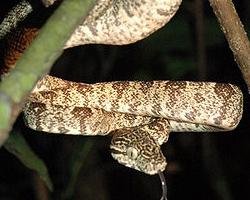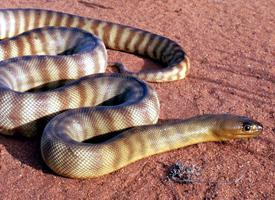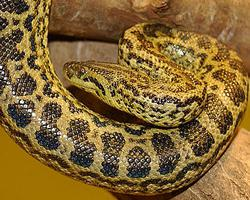
Súlyok és méretek
| Hossz | 2,5 m |
|---|
Veszélyeztetettség
| Rettenthetetlen |
Állatleírás
The Amazon Tree Boa (Corallus hortulanus) is a fascinating and visually striking species of non-venomous snake native to the lush rainforests of South America. Belonging to the family Boidae, this arboreal serpent is renowned for its remarkable adaptability and diverse coloration, making it a subject of interest among herpetologists and reptile enthusiasts alike.Characteristically slender and agile, the Amazon Tree Boa possesses a muscular body that is ideally suited for an arboreal lifestyle. Adults can reach lengths of approximately 5 to 7 feet (1.5 to 2.1 meters), though some specimens have been reported to grow even longer. Their prehensile tails, which are capable of grasping and holding onto branches, play a pivotal role in their navigation through the dense canopy of the rainforest.
One of the most striking features of the Amazon Tree Boa is its wide array of color morphs. Their skin can display a broad spectrum of colors, ranging from vibrant yellows and oranges to more subdued browns and greens. This variation not only contributes to their aesthetic appeal but also aids in camouflage, allowing them to blend seamlessly into their surroundings. Additionally, they exhibit patterns that may include bands, stripes, or more irregular shapes, further enhancing their ability to evade predators and ambush prey.
The diet of the Amazon Tree Boa primarily consists of small mammals, birds, and occasionally lizards. They are ambush predators, relying on the element of surprise to capture their prey. Utilizing their keen sense of sight and heat-sensing pits located on their jaws, they can detect and strike at prey with remarkable precision, even in low-light conditions. Once their prey is secured, they employ constriction as their method of subdual, wrapping their powerful bodies around the victim and tightening their grip until suffocation occurs.
Reproduction in Amazon Tree Boas is ovoviviparous, meaning the females give birth to live young. After a gestation period that can last several months, a female may give birth to a litter of 5 to 15 offspring. The neonates are independent from birth, equipped with the instincts and abilities necessary for survival in the dense canopy of the rainforest.
Despite their fearsome appearance and predatory nature, Amazon Tree Boas pose no significant threat to humans. They are non-venomous and generally shy, preferring to avoid encounters with people. However, like many wild animals, they may defend themselves if threatened or provoked, typically by striking or attempting to bite.
In conclusion, the Amazon Tree Boa is a remarkable example of adaptation and survival in the tropical rainforests of South America. Its diverse coloration, arboreal agility, and efficient hunting strategies make it a compelling subject of study and admiration. As with many species inhabiting the world's rainforests, the conservation of their natural habitat is crucial to their continued survival, highlighting the importance of environmental preservation efforts in these regions.
Hasonló állatok
Új állatfotók
Top 10 állat
- Dolphin gull (Leucophaeus scoresbii)
- Diana monkey (Cercopithecus diana)
- Moustached guenon (Cercopithecus cephus)
- Galápagos tortoise (Geochelone nigra complex)
- Japanese macaque (Macaca fuscata)
- Stone loach (Barbatula barbatula)
- Russian tortoise (Testudo horsfieldii)
- Greek tortoise (Testudo graeca)
- Common flying dragon (Draco volans)
- Vendace (Coregonus albula)


